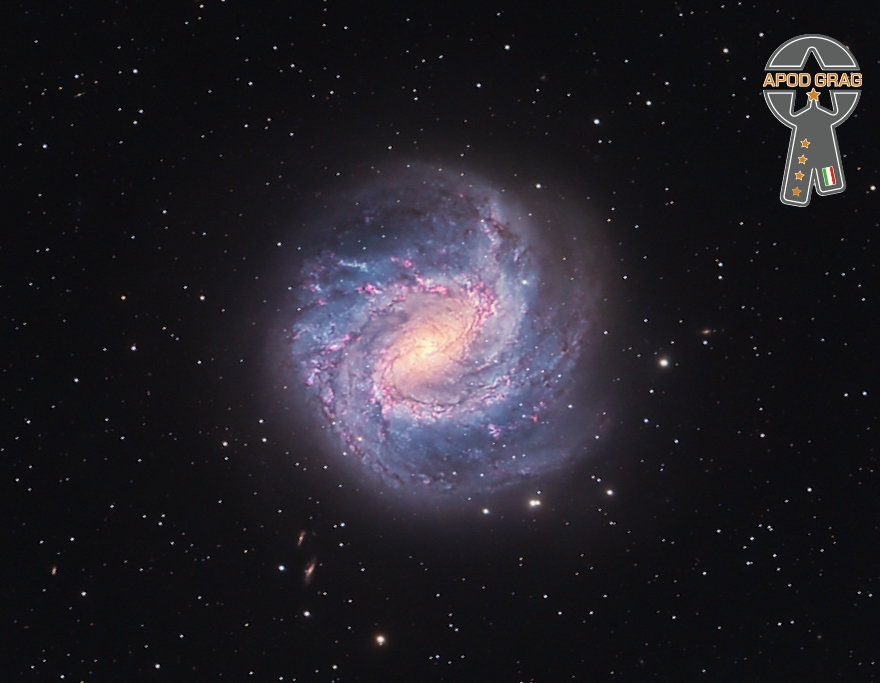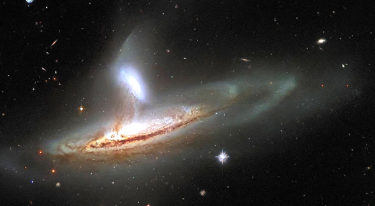Blog
The highly irregular galaxy ESO 174-1, which resembles a lonely, hazy cloud against a backdrop of bright stars, dominates this image from the NASA/ESA Hubble Space Telescope. ESO 174-1 lies around 11 million light-years from Earth and consists of a bright cloud of stars and a faint, meandering tendril of dark gas and dust. This image is part of a collection of Hubble observations that aims to get to know our nearby galactic neighbours. To be more precise, the observations aim to resolve the brightest stars and basic properties of every known galaxy within 10 megaparsecs. A parsec is a unit used by astronomers to measure the vast distances to other galaxies — 10 megaparsecs translates to 32 million light-years — and makes astronomical distances easier to handle. For example, the nearest star to the Sun, Proxima Centauri, is about 1.3 parsecs away. In everyday units this is a staggering 40 million million kilometres! The programme to capture all of our neighbouring galaxies was designed to use the 2-3% of Hubble time that absolutely no other observing programme can use. Many of the myriad objects that Hubble observes can only be seen at certain times of year, which makes filling out the observatory’s schedule a daunting logistical challenge. Observing programmes such as the one which captured ESO 174-1 help Hubble’s operators get the most out of every last minute of observing time. [Image Description: A galaxy, large and occupying most of the view from the centre. The whole galaxy is made of smooth, diffuse light. In the centre it is brighter and bluer, fading to a pale grey halo that is faint and see-through. The light forms an arm on one side that curls around the top. A couple threads of dark dust cross the centre. Many stars shine around the galaxy, on a black background.]

Anthony John Medeski (born June 28, 1965) is an American jazz keyboard player and composer. Medeski is a veteran of New York’s 1990s avant-garde jazz scene and is known popularly as a member of Medeski Martin & Wood. He plays the acoustic piano and an eclectic array of keyboards, including the Hammond B3organ, melodica, mellotron, clavinet, ARP String Ensemble, Wurlitzer electric piano, Moog Voyager Synthesizer, Wurlitzer 7300 Combo Organ, Vox Continental Baroque organ, and Yamaha CS-1 Synthesizer (a “kids’ toy”), among others. When playing acoustic piano, Medeski usually plays the Steinway piano and is listed as a Steinway Artist.
Medeski was born in Louisville, Kentucky, and grew up in Florida. After studying piano as a child (starting when he was five years old), he began as a teenager to perform with musicians such as Mark Murphy and Jaco Pastorius. He attended Pine Crest School. In 1983, after graduating from high school, he began studying piano at the New England Conservatory in Boston, where he performed as a sideman with Dewey Redman, Billy Higgins, Bob Mintzer, Alan Dawson. Medeski attributes his early interest in playing improvised music and jazz to listening to Oscar Peterson.
more...David “Honeyboy” Edwards (June 28, 1915 – August 29, 2011) was a Delta blues guitarist and singer from Mississippi.
Edwards was born in Shaw, Mississippi. He learned to play music from his father, a guitarist and violinist.At the age of 14, he left home to travel with the bluesman Big Joe Williams, beginning life as an itinerant musician, which he maintained through the 1930s and 1940s. He performed with the famed blues musician Robert Johnson, with whom he developed a close friendship. Edwards was present on the night Johnson drank the poisoned whiskey that killed him, and his story has become the definitive version of Johnson’s demise.
more...Joe “Fox” Smith (né Joseph Emory Smith; June 28, 1902 – December 2, 1937) was an American jazz trumpeter.
Known throughout his childhood as “Toots”, Smith originally started as a drummer but was convinced by Ethel Waters that he was far better as a trumpet player. It has been said that when he reached New York in 1920 he already had a fully formed style, which achieved “the vocalized sound, the blues spirit and the swing which makes for convincing jazz performance”.
In 1921, Smith joined the Black Swan Jazz Masters in Chicago, Illinois, directed at the time by Fletcher Henderson who described Smith as “the most soulful trumpet I ever had”. He also worked with the Jazz Hounds, the Broadway Syncopators, and finally with McKinney’s Cotton Pickers throughout the 1920s. He became famous from his work accompanying Bessie Smith, recording over 30 records. She stated that Smith was her preferred cornetist when recording, due to his reserved additions to her voice.Some of the other artists he worked with include Billy Paige, Noble Sissle, Eubie Blake, and Allie Ross.
more...- Messier 83 or M83, also known as the Southern Pinwheel Galaxy and NGC 5236, is a barred spiral galaxy approximately 15 million light-yearsaway in the constellation borders of Hydra and Centaurus. Nicolas-Louis de Lacaille discovered M83 on 23 February 1752 at the Cape of Good Hope. Charles Messier added it to his catalogue of nebulous objects (now known as the Messier Catalogue) in March 1781.

James Evans Fuller (June 27, 1947 – March 3, 2017) was the lead guitaristand main songwriter for the 1960s rock band The Surfaris.
Fuller was known as the “Godfather” of surf music, a Californian instrumental music.
He was also a studio musician, and performed on many other artists’ such as “The Seeds”, rock, folk, and blues songs throughout his career, performing vocals, lead and bass guitar.
Fuller, with his Fender Stratocaster guitar in photographs and its sound on The Surfaris albums, contributed to the popularity of Leo Fender‘s instruments.
He is featured on “Hollywood’s Rock Walk of Fame”.
As of 2004 he continued to perform with The Surfaris and his other band, “Jim Fuller & The Beatnik” with a fan base in United States, Europe, and Japan.
He died on March 3, 2017, in Arcadia, California, at the age of 69.
Along with the rest of the Surfaris, Fuller was inducted into the Musicians Hall of Fame in 2019.
more...Joseph Edward Covington (born Joseph Edward Michno; June 27, 1945 – June 4, 2013) was an American drummer, best known for his involvements with Jefferson Airplane, Hot Tuna[1] and Jefferson Starship.
more...Johnny “Big Moose” Walker (June 27, 1927 – November 27, 1999) was an American Chicago blues and electric blues pianist and organist. He worked with many blues musicians, including Ike Turner, Sonny Boy Williamson II, Lowell Fulson, Choker Campbell, Elmore James, Earl Hooker, Muddy Waters, Otis Spann, Sunnyland Slim, Jimmy Dawkins and Son Seals.[2]
more...St. Elmo Sylvester Hope (June 27, 1923 – May 19, 1967) was an American jazz pianist, composer, and arranger, chiefly in the bebop and hard bopgenres. He grew up playing and listening to jazz and classical music with Bud Powell, and both were close friends of another influential pianist, Thelonious Monk.
more...The image shows Arp 282, an interacting galaxy pair composed of the Seyfert galaxy NGC 169 (bottom) and the galaxy IC 1559 (top).
Interestingly, both galaxies have monumentally energetic cores known as active galactic nuclei (AGN), although that is difficult to tell from this image, which is fortunate.
If the image revealed the full emission of both AGNs, their brilliance would obscure the beautifully detailed tidal interactions we see in this image.
Tidal forces occur when an object’s gravity causes another object to distort or stretch. The direction of tidal forces is away from the lower-mass object and toward the higher-mass object.
When two galaxies tidally interact, gas, dust, and even entire star systems can move toward one galaxy and away from the other. The image reveals this process in action as delicate streams of matter visibly link the two galaxies. 
Rubén López Fürst ( June 26 , 1937 ; Buenos Aires , Argentina – July 25 , 2000 ; Buenos Aires , Argentina ) wasan Argentine jazz pianist and composer.
more...
Big Bill Broonzy (born Lee Conley Bradley; June 26, 1903 August 14, 1958) was an American bluessinger, songwriter, and guitarist. His career began in the 1920s, when he played country music to mostly African-American audiences. In the 1930s and 1940s, he navigated a change in style to a more urban bluessound popular with working-class black audiences. In the 1950s, a return to his traditional folk-blues roots made him one of the leading figures of the emerging American folk music revivaland an international star. His long and varied career marks him as one of the key figures in the development of blues music in the 20th century.
more...Reginald “Reggie” Workman (born June 26, 1937, in Philadelphia, Pennsylvania)[1] is an American avant-garde jazz and hard bop double bassist, recognized for his work with both John Coltrane and Art Blakey.
more...Robert David Grusin (born June 26
1934) is an American composer, arranger, producer, jazz pianist, and band leader. He has composed many scores for feature films and television, and has won numerous awards for his soundtrack and record work, including an Academy Award and 10 Grammy Awards. In 1978, Grusin founded GRP Records with Larry Rosen, and was an early pioneer of digital recording.
more...More Posts
- The Cosmos with NGC 6872 & IC 4970
- Paul McCartney Day
- William Hooker Day
- Rudy Rutherford Day
- World Fusion with Manika Kaur
- Daily Roots with the Congos
- Happy Fathers Day 2018
- The Cosmos with RCW 108
- Chuck Rainey Day
- Sing Miller Day
- World Music with Corvus Corax
- Daily Roots with ITSJAHMIEL
- The Cosmos with NGC 3372
- Lucky Thompson Day
- World Music with Sherrifo Konteh
- Daily Roots with Culture
- The Cosmos with NGC 3190
- Jaki Byard Day
- Erroll Garner Day